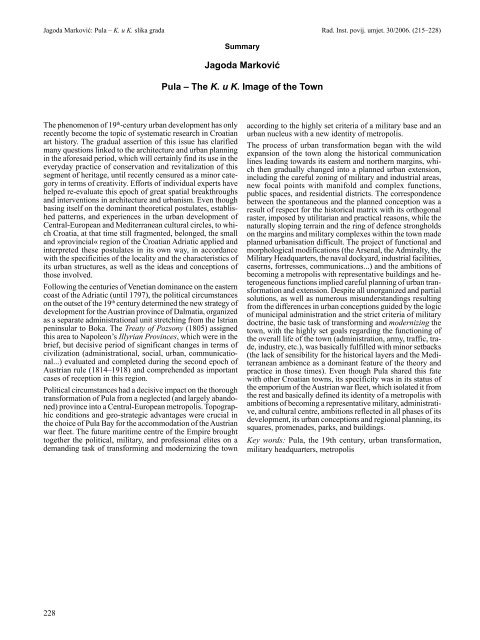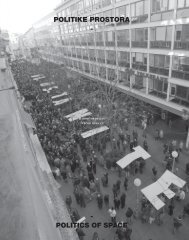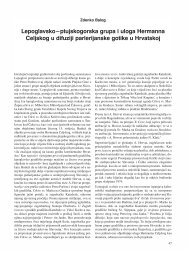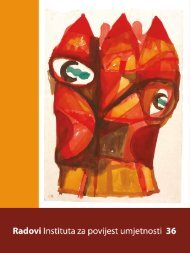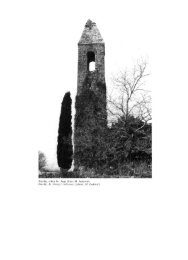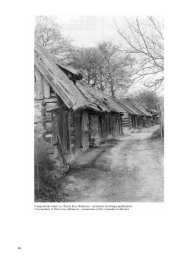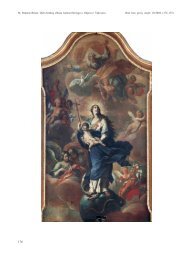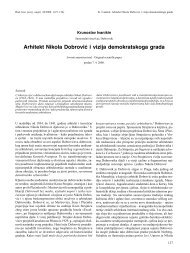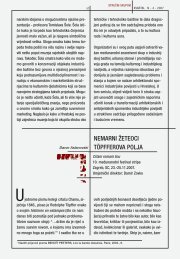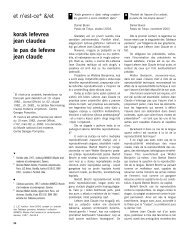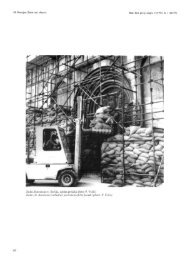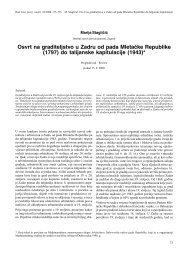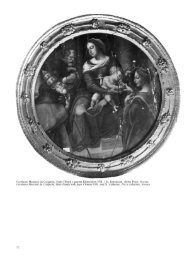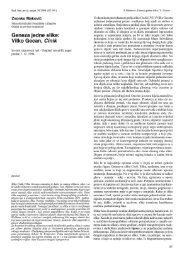Pula – K. u. K. slika grada - Institut za povijest umjetnosti
Pula – K. u. K. slika grada - Institut za povijest umjetnosti
Pula – K. u. K. slika grada - Institut za povijest umjetnosti
You also want an ePaper? Increase the reach of your titles
YUMPU automatically turns print PDFs into web optimized ePapers that Google loves.
Jagoda Marković: <strong>Pula</strong> <strong>–</strong> K. u K. <strong>slika</strong> <strong>grada</strong> Rad. Inst. povij. umjet. 30/2006. (215<strong>–</strong>228)<br />
The phenomenon of 19thcentury urban development has only<br />
recently become the topic of systematic research in Croatian<br />
art history. The gradual assertion of this issue has clarified<br />
many questions linked to the architecture and urban planning<br />
in the aforesaid period, which will certainly find its use in the<br />
everyday practice of conservation and revitali<strong>za</strong>tion of this<br />
segment of heritage, until recently censured as a minor category<br />
in terms of creativity. Efforts of individual experts have<br />
helped reevaluate this epoch of great spatial breakthroughs<br />
and interventions in architecture and urbanism. Even though<br />
basing itself on the dominant theoretical postulates, established<br />
patterns, and experiences in the urban development of<br />
CentralEuropean and Mediterranean cultural circles, to which<br />
Croatia, at that time still fragmented, belonged, the small<br />
and »provincial« region of the Croatian Adriatic applied and<br />
interpreted these postulates in its own way, in accordance<br />
with the specificities of the locality and the characteristics of<br />
its urban structures, as well as the ideas and conceptions of<br />
those involved.<br />
Following the centuries of Venetian dominance on the eastern<br />
coast of the Adriatic (until 1797), the political circumstances<br />
on the outset of the 19th century determined the new strategy of<br />
development for the Austrian province of Dalmatia, organized<br />
as a separate administrational unit stretching from the Istrian<br />
peninsular to Boka. The Treaty of Pozsony (1805) assigned<br />
this area to Napoleon’s Illyrian Provinces, which were in the<br />
brief, but decisive period of significant changes in terms of<br />
civili<strong>za</strong>tion (administrational, social, urban, communicational...)<br />
evaluated and completed during the second epoch of<br />
Austrian rule (1814<strong>–</strong>1918) and comprehended as important<br />
cases of reception in this region.<br />
Political circumstances had a decisive impact on the thorough<br />
transformation of <strong>Pula</strong> from a neglected (and largely abandoned)<br />
province into a CentralEuropean metropolis. Topographic<br />
conditions and geostrategic advantages were crucial in<br />
the choice of <strong>Pula</strong> Bay for the accommodation of the Austrian<br />
war fleet. The future maritime centre of the Empire brought<br />
together the political, military, and professional elites on a<br />
demanding task of transforming and modernizing the town<br />
228<br />
Summary<br />
Jagoda Marković<br />
<strong>Pula</strong> <strong>–</strong> The K. u K. Image of the Town<br />
according to the highly set criteria of a military base and an<br />
urban nucleus with a new identity of metropolis.<br />
The process of urban transformation began with the wild<br />
expansion of the town along the historical communication<br />
lines leading towards its eastern and northern margins, which<br />
then gradually changed into a planned urban extension,<br />
including the careful zoning of military and industrial areas,<br />
new focal points with manifold and complex functions,<br />
public spaces, and residential districts. The correspondence<br />
between the spontaneous and the planned conception was a<br />
result of respect for the historical matrix with its orthogonal<br />
raster, imposed by utilitarian and practical reasons, while the<br />
naturally sloping terrain and the ring of defence strongholds<br />
on the margins and military complexes within the town made<br />
planned urbanisation difficult. The project of functional and<br />
morphological modifications (the Arsenal, the Admiralty, the<br />
Military Headquarters, the naval dockyard, industrial facilities,<br />
caserns, fortresses, communications...) and the ambitions of<br />
becoming a metropolis with representative buildings and heterogeneous<br />
functions implied careful planning of urban transformation<br />
and extension. Despite all unorganized and partial<br />
solutions, as well as numerous misunderstandings resulting<br />
from the differences in urban conceptions guided by the logic<br />
of municipal administration and the strict criteria of military<br />
doctrine, the basic task of transforming and modernizing the<br />
town, with the highly set goals regarding the functioning of<br />
the overall life of the town (administration, army, traffic, trade,<br />
industry, etc.), was basically fulfilled with minor setbacks<br />
(the lack of sensibility for the historical layers and the Mediterranean<br />
ambience as a dominant feature of the theory and<br />
practice in those times). Even though <strong>Pula</strong> shared this fate<br />
with other Croatian towns, its specificity was in its status of<br />
the emporium of the Austrian war fleet, which isolated it from<br />
the rest and basically defined its identity of a metropolis with<br />
ambitions of becoming a representative military, administrative,<br />
and cultural centre, ambitions reflected in all phases of its<br />
development, its urban conceptions and regional planning, its<br />
squares, promenades, parks, and buildings.<br />
Key words: <strong>Pula</strong>, the 19th century, urban transformation,<br />
military headquarters, metropolis


